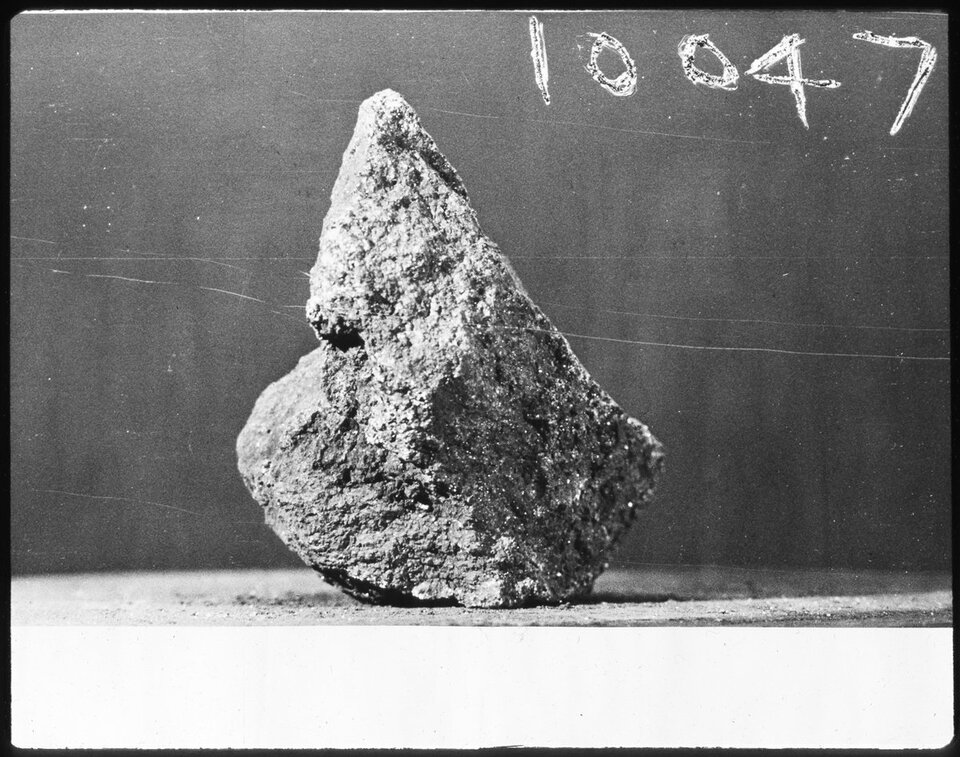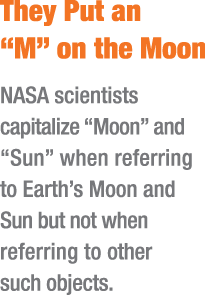
Moon Gazing: The Long Story of Lunar Research at Caltech
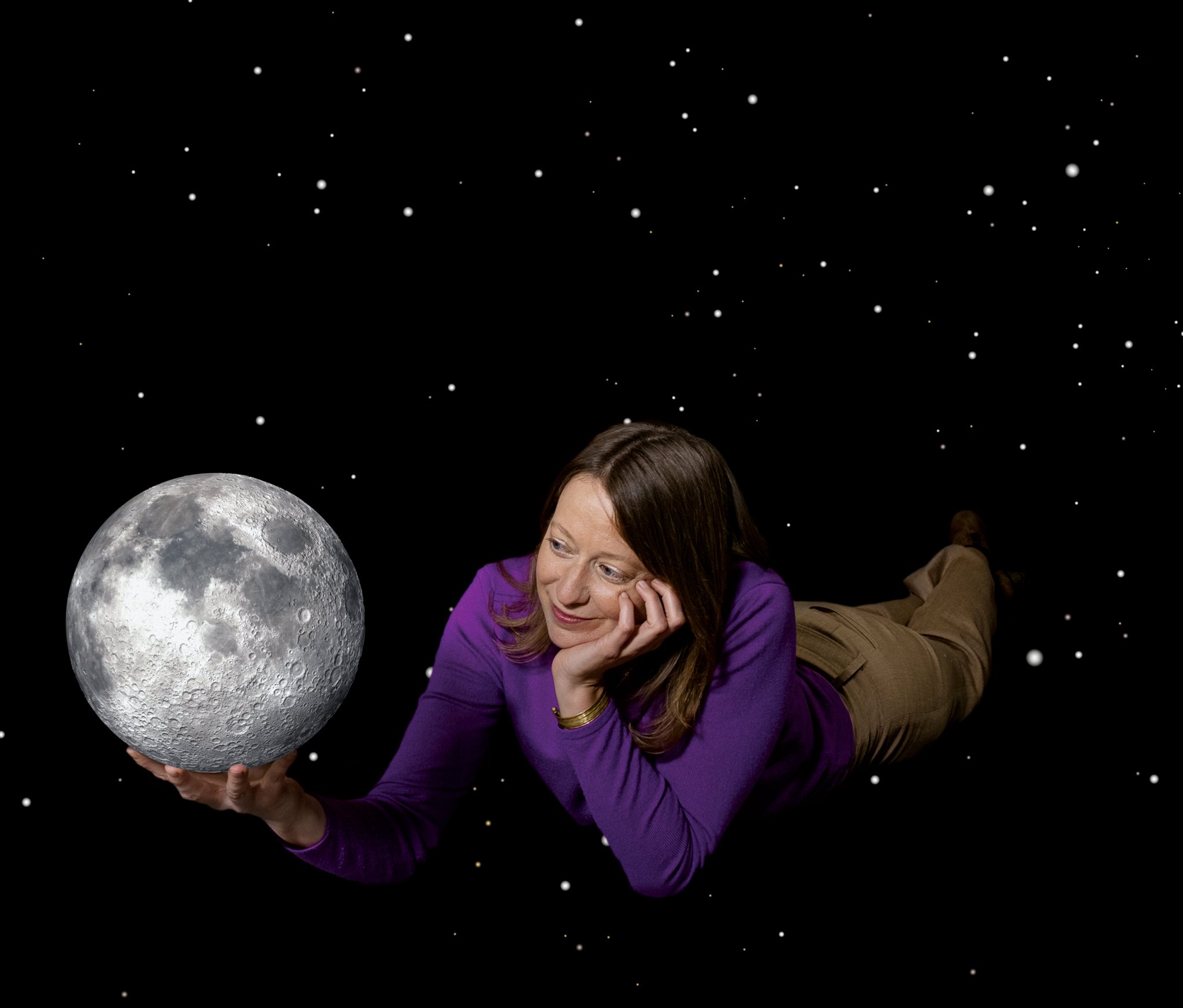
NASA’s Lunar Trailblazer mission marks a new chapter in Caltech’s enduring exploration of Earth’s closest celestial companion.
BY KER THAN for Caltech Magazine - https://magazine.caltech.edu/post/lunar-trailblazer-moon-research
One of the most incredible discoveries about the Moon in recent times was made when no one was expecting it. In 2009, NASA’s Moon Mineralogy Mapper (M3) instrument on India’s Chandrayaan-1 mission was mapping the composition of geological features on the lunar surface when it detected something surprising: reflected light from the near-polar regions of the Moon, carrying a possible spectral signature of water. The water signal M3 observed was present even in lunar regions exposed to sunlight, where temperatures can climb well above boiling. The improbable discovery—confirmed by two other spacecraft, Cassini and Deep Impact—challenged the prevailing wisdom of the time that the Moon was a mostly dry, dusty, and rocky world. Instead, it suggested water (H2O) or hydroxide (OH-) could be continuously forming and sublimating on the lunar surface through a geochemical reaction with the solar wind. It pointed to a possible water cycle on airless bodies, building upon an earlier 2008 discovery by NASA’s Lunar Crater Observation and Sensing Satellite (LCROSS) of water ice in permanently shadowed regions of the Moon.
In the years since, the debate over how water ice got to the Moon has focused on two possibilities: one scenario involves comets and “wet asteroids” crashing into the Moon, while the other entails ancient volcanic eruptions disgorging water vapor from the Moon’s interior and depositing frost on its surface.
Scientists will soon have another chance to investigate the mystery of the Moon’s water thanks to NASA’s Lunar Trailblazer spacecraft, which is scheduled to begin operation later this year. Bethany Ehlmann, professor of planetary science at Caltech, serves as principal investigator of the mission, which is managed by the Jet Propulsion Laboratory (JPL).
Lunar Trailblazer is one of five missions of NASA’s Small Innovative Missions for Planetary Exploration (SIMPLEx) program, which holds competitions to select high-risk, low-budget small spacecraft to perform focused explorations of other planets, moons, and asteroids. Its task will be to understand the form, abundance, and distribution of water on the Moon, as well as the lunar water cycle.
Lunar Trailblazer could also aid future human exploration of the solar system by identifying “operationally useful” deposits of water on the Moon. The diminutive spacecraft—weighing about 450 pounds and measuring only 11.5 feet wide with its solar panels fully deployed—will launch as a “rideshare,” or secondary payload, on the lunar lander mission IM-2 by Intuitive Machines in late 2023. “Lunar Trailblazer is among the first of a new class of small satellites that will do important planetary science at a much lower price point with a high science value per dollar,” says Ehlmann, who is also associate director of Caltech’s Keck Institute for Space Studies.
Lunar Trailblazer will carry two instruments: the High-resolution Volatiles and Minerals Moon Mapper (HVM3), built by JPL, and the Lunar Thermal Mapper (LTM), built by the University of Oxford and contributed by the UK Space Agency. When used in conjunction, the instruments will provide scientists with five key pieces of information about the Moon’s water: in addition to its form, distribution, and quantity, they will measure temperature and examine the mineralogical composition of the lunar rocks and regolith (loose deposits of dust and other materials). Lunar Trailblazer will map just 2 percent of the Moon’s surface during its primary mission, but what it lacks in total coverage it will make up for in the quality of its data.
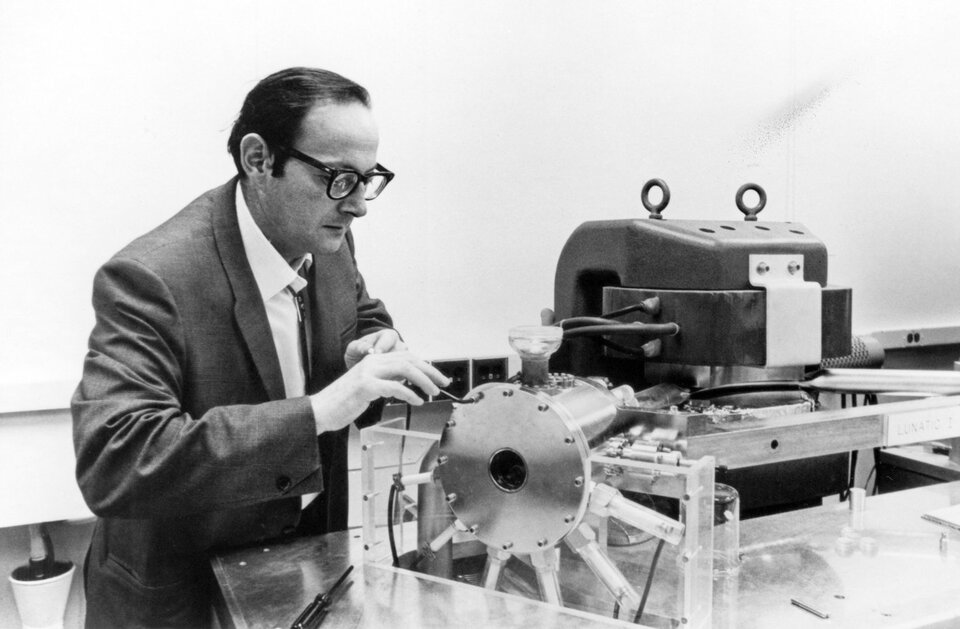
Gerald Wasserburg, the late John D. MacArthur Professor of Geology and Geophysics, Emeritus, with the Lunatic I mass spectrometer in 1969. Courtesy of Caltech Archives
“Ours will be the highest spatial resolution mapping dataset to date for the lunar surface’s water content, temperature, and composition,” Ehlmann says. “Missions that have gone before us have produced global or near-global maps of the Moon, so we know where the most interesting spots are, and Lunar Trailblazer is following up and targeting them at many factors higher resolution.”
The HVM3 instrument that will fly aboard Lunar Trailblazer resembles an instrument flown aboard the Mars Reconnaissance Orbiter called the Compact Reconnaissance Imaging Spectrometer for Mars, or CRISM, which Ehlmann used as a graduate student to map the surface of Mars and which also influenced the design of the M3 instrument that first found water experience. We’ll be in a better position next time around when we suggest using this technique from the ground.”
Lunar Trailblazer is also able to detect other icy volatiles, which are compounds that tend to vaporize easily, such as organics, carbon dioxide, ammonia, or hydrogen sulfide ice, which the Moon might have. The chemical makeup of these ices—whether they contain more sulfur or nitrogen, for example—could provide clues about the origin of the Moon’s water via comets or volcanism. “My hope is that not only are we going to detect water, but that Trailblazer will also detect small amounts of these other ices,” Ehlmann says. “That would be a bonus finding.”
The benefits that flow from Lunar Trailblazer could extend even beyond the Moon. “I suspect we’ll learn quite a bit about ice spectroscopic signatures, which will benefit the study of Mars but also contribute to the understanding of water cycles on other airless bodies in our solar system such as Mercury and asteroids,” Ehlmann says. “Lunar Trailblazer will really demonstrate the power of small satellites to answer important questions in planetary science.”
A Storied History
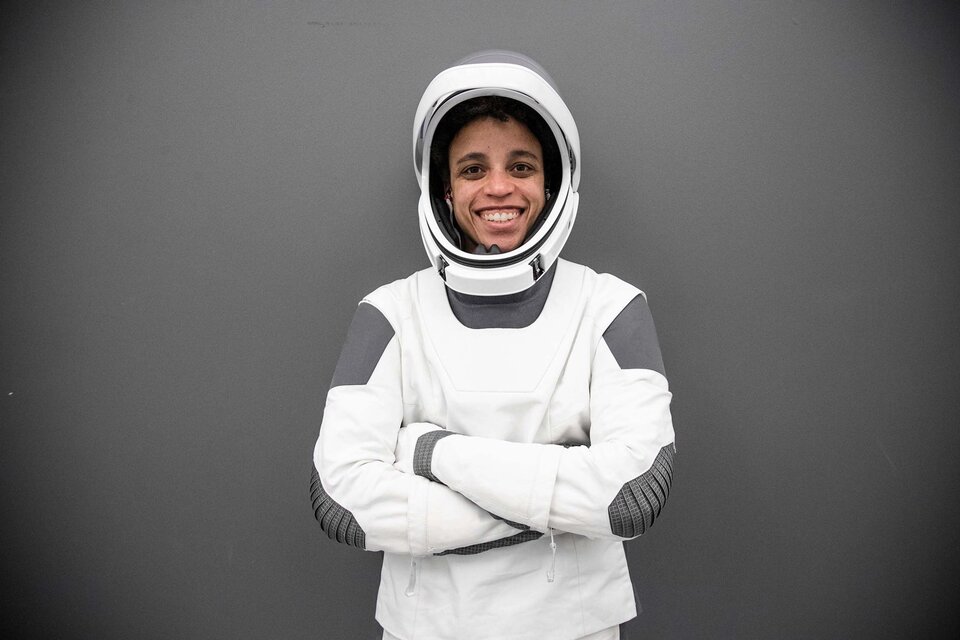
Former Caltech postdoc Jessica Watkins is a member of NASA’s Artemis mission team, which will usher in a new era of lunar research. NASA Johnson, https://creativecommons.org/licenses/by-nc-nd/2.0/
Lunar Trailblazer is just the latest in a long, rich history of lunar missions involving Caltech and JPL, which Caltech manages for NASA. The Surveyor and Ranger missions in the 1960s that helped NASA gather data about the Moon in preparation for the manned Apollo missions were managed by JPL. Caltech geologists and geophysicists, among the first to analyze material hauled back from the Moon, helped train Apollo astronauts; more on that below. The first scientist-astronaut to walk on the Moon—and one of the last people to step off it—was Caltech graduate and Apollo 17 crew member Harrison “Jack” Schmitt (BS ’57). And former Caltech postdoc Jessica Watkins is a member of Artemis, a team of 18 astronauts who will help pave the way for NASA’s next lunar missions, which will include sending humans back to the Moon.
Caltech scientists have also been integral to investigating many fundamental questions about the Moon, including its origins, age, history, and evolution, in addition to the presence and quantity of water. In 1961, Caltech scientists proposed the existence of cold traps—shadowy patches that captured and protected water deposited on the lunar surface. It would be almost 40 years before NASA’s Lunar Prospector spacecraft confirmed their hypothesis. Through the 1960s and ’70s, Caltech geochemists made many of the first scientific discoveries to come from the Apollo program, including the first precise understanding of the ages and histories of the rocks on the lunar surface. Caltech’s David Stevenson helped fill in crucial details in the late 1980s about how the Moon might have been born from a cataclysmic impact between Earth and a Mars-sized object.
“What we and other people realized is that in order to get into a situation where you could make the Moon, you needed a large impact,” says Stevenson, the Marvin L. Goldberger Professor of Planetary Science, Emeritus. It is thought that an ancient collision created an orbiting debris disk around Earth that coalesced into the Moon. “We argued at the time that the formation of the Moon after a giant impact was determined by the rate at which energy is lost from the Earth-Moon system by radiation. And that’s something on the order of hundreds to a thousand years. So, we’re talking about a very fast process.”
Ehlmann says she is excited to participate in and extend Caltech’s long arc of lunar exploration. “Caltech is one of those institutions that was there from the beginning, and I’m very happy to continue that tradition of discovery of the Moon and also pave the way for the next generation of explorers,” she says.
‘Just put them in the bag!’
Like millions of others at the time, Dimitri Papanastassiou (BS ’65, PhD ’70) watched in rapt attention as the Apollo astronauts traipsed, skipped, and trundled across the gray lunar surface. He paid particularly close attention when astronauts on the later Apollo missions picked up samples from the Moon. “I kept thinking, don’t keep looking at the samples. Just put them in the bag!” Papanastassiou says.
His vested interest stemmed from the knowledge (and hope) that some of the lunar samples collected by the Apollo astronauts would wind up at Caltech for study. “They were spending too much time discussing what they were seeing and debating whether to take this rock or the other one,” Papanastassiou says. “Pick up both!” he says he wanted to tell them. “You have the capability; you don’t have to decide!”
By the time Neil Armstrong made his famous small step on the Moon in the summer of 1969, Papanastassiou had already been a graduate student at Caltech for several years. Most of that time he spent working feverishly with Gerald Wasserburg, the late John D. MacArthur Professor of Geology and Geophysics, Emeritus, to construct a high-precision mass spectrometer designed specifically for interrogating Moon samples. The instrument, which separates ionized atoms according to their mass, was dubbed Lunatic I.
Wasserburg and five other Caltech faculty members—geologist Leon Silver (PhD ’55), geochemist Samuel Epstein, geologist and planetary scientist Arden Albee, geologist Hugh Taylor Jr. (BS ’54, PhD ’59), and Donald Burnett, Caltech professor of nuclear geochemistry, emeritus—were among the 100 or so scientists selected by NASA to analyze the Apollo astronauts’ lunar haul. Geochemist Clair Patterson also played a crucial role in developing the clean-room technologies that allowed Caltech scientists to extract and process trace amounts of materials from the lunar samples without fear of contamination.
Lunatic I was the first fully digital instrument of its kind, and its precision was 30 times better than any that came before. Lunatic I—now held in the collections of the National Museum of American History—was a decisive factor in NASA’s decision to entrust Moon samples to Caltech for study, according to Burnett. “We were fully expecting that we would be approved to do this because we knew we had the best ways of doing it. We had been planning since 1966 on. We were ready, and it was all based on the Lunatic I mass spectrometer,” he says.
But the Caltech scientists’ confidence was tempered by the knowledge that all the preparation in the world would not matter if the lunar samples failed to make it to Earth in good condition. “If we were delivered a sample, we could do all this analysis on it,” Burnett says. “But whether the samples got back safely and were not ruined in the process of reentry and recovery—that was far from obvious. We were terrified.”
Fortunately, the Apollo astronauts delivered, ultimately carting home more than 800 pounds of lunar rocks and soil. With Lunatic I’s unrivaled precision, Wasserburg and his colleagues determined that the igneous samples returned by the Apollo missions defined an extended range of volcanic activity between 3 billion to 3.9 billion years ago. Lunatic I also played a key role in discovering the first evidence of the “late heavy bombardment,” a period roughly 4 billion years ago when the bodies of the inner solar system were pummeled by asteroids and comets.
“The Apollo program started off for political reasons. It was not done for science. It was done to show that we could beat the Soviets,” Burnett says. “But what’s left standing now is the science that has come out of the lunar samples. That is the true legacy of the Apollo missions.”
The Caltech scientists contributed to the Apollo program in other ways too. Wasserburg belonged to a select cadre of senior scientists known as the “Four Horsemen” who advised NASA throughout the Apollo missions. Silver, the late W. M. Keck Foundation Professor for Resource Geology, Emeritus, instructed the crews of the Apollo 13, 15, 16, and 17 missions in geology. Silver often took his astronaut students to the Orocopia Mountains in the desert southeast of Indio, California, where he would teach them how to assess, analyze, and record their surroundings like a geologist.
Caltech faculty were crucial to the success of the Apollo program, says Asif Siddiqi, a space historian at Fordham University and a former Eleanor Searle Visiting Professor of History at Caltech and The Huntington Library, Art Museum, and Botanical Gardens. “You can’t really tell the story of Apollo without them,” he says.
With Lunar Trailblazer, Siddiqi adds, Caltech is once again at the forefront of lunar research. “Caltech has already staked its claim on the history of lunar science. Lunar Trailblazer has the potential to really add fundamentally to our knowledge of the Moon,” he says. “It’s one of the most exciting missions to the Moon that I can think of
right now.”
- Date: May 15th, 2023
- Category: Project News
- View Image
- Image Caption: Bethany Ehlmann. Photo: Sergio Solorzano

